标签:ica 直接 命名空间 display 简单 之间 描述 常用 计算
TensorFlow应用程序需要引入编程架包,才能访问TensorFlow的类、方法和符号。如下所示的方法:
|
import tensorflow as tf |
TensorFlow用Tensor这种数据结构来表示所有的数据。可以把一个Tensor想象成一个n维的数组或列表。Tensor有一个静态的类型和动态的维数。Tensor可以在图中的节点之间流通。
Tensor对象由原始数据组成的多维的数组,Tensor的rank(秩)其实是表示数组的维数,如下所示的tensor例子:
|
Rank |
数学实例 |
Python 例子 |
|
0 |
常量 (只有大小) |
s = 483 |
|
1 |
向量(大小和方向) |
v = [1.1, 2.2, 3.3] |
|
2 |
矩阵(数据表) |
m = [[1, 2, 3], [4, 5, 6], [7, 8, 9]] |
|
3 |
3阶张量 (数据立体) |
t = [[[2], [4], [6]], [[8], [10], [12]], [[14], [16], [18]]] |
|
n |
n阶 (自己想想看) |
… |
TensorFlow为了描述Tensor每一维的长度,相当于描述每一维数组的长度,所以定义了Shape概念。其可以描述Tensor的维数,又可以描述每一维的长度。
|
Rank |
Shape |
Dimension number |
Example |
|
0 |
[] |
0-D |
一个常量. |
|
1 |
[D0] |
1-D |
[5]:表示一个向量有5个元素 |
|
2 |
[D0, D1] |
2-D |
[3, 4]:表示一个矩阵,共有3*4个元素 |
|
3 |
[D0, D1, D2] |
3-D |
[2, 4, 3]:总共有2*4*3个元素 |
|
n |
[D0, D1, D2,… DN-1] |
n-D |
…. |
除了维度,Tensor有一个数据类型属性,你可以为一个张量指定下列数据类型中的任意一个类型,但是一个Tensor所有元素的类型必须相同。
|
数据类型 |
Python 类型 |
描述 |
|
DT_FLOAT |
tf.float32 |
32 位浮点数. |
|
DT_DOUBLE |
tf.float64 |
64 位浮点数. |
|
DT_INT64 |
tf.int64 |
64 位有符号整型. |
|
DT_INT32 |
tf.int32 |
32 位有符号整型. |
|
DT_INT16 |
tf.int16 |
16 位有符号整型. |
|
DT_INT8 |
tf.int8 |
8 位有符号整型. |
|
DT_UINT8 |
tf.uint8 |
8 位无符号整型. |
|
DT_STRING |
tf.string |
可变长度的字节数组.每一个张量元素都是一个字节数组. |
|
DT_BOOL |
tf.bool |
布尔型. |
|
DT_COMPLEX64 |
tf.complex64 |
由两个32位浮点数组成的复数:实数和虚数. |
|
DT_QINT32 |
tf.qint32 |
用于量化Ops的32位有符号整型. |
|
DT_QINT8 |
tf.qint8 |
用于量化Ops的8位有符号整型. |
|
DT_QUINT8 |
tf.quint8 |
用于量化Ops的8位无符号整型. |
Computational graph 是由一系列边(Tensor)和节点(operation)组成的数据流图。每个节点都是一种操作,其有0个或多个Tensor作为输入边,且每个节点都会产生0个或多个Tensor作为输出边。即节点是将多条输入边作为操作的数据,然后通过操作产生新的数据。可以将这种操作理解为模型,或一个函数,如加减乘除等操作。
简单地说,可以将Computational graph理解为UML的活动图,活动图和Computational graph都是一种动态图形。TensorFlow的节点(操作)类似活动图的节点(动作),TensorFlow每个节点都有输入(Tensor),可以将用户创建的起始Tensor看做是活动图的起始节点,而TensorFlow最终产生的Tensor看做是活动图的终止节点,如图 31所示。
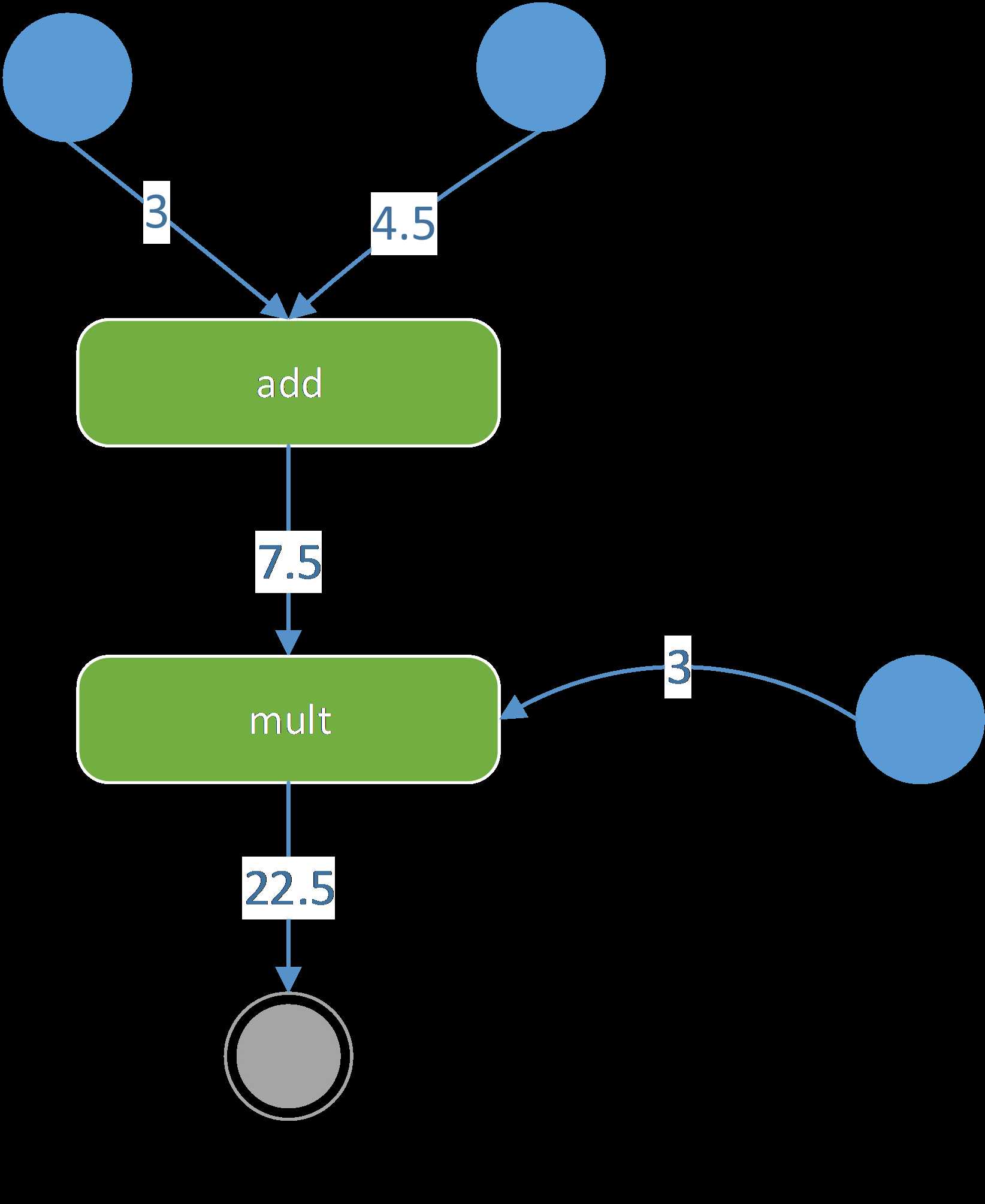
图 31
图 31所示,常量3和常量4.5两个起始Tensor通过add操作后产生了一个新Tensor(值7.5);接着新Tensor(值7.5)和常量3经multi操作后产生一个新Tensor(值22.5),因为22.5是TensorFlow最后产生的Tensor,所以其是终止节点。
TensorFlow通过一个对象(Session)来管理Computational graph 节点动态变换。由于Tensor是一种数据结构,为了获取Tensor存储的数据,需要手动调用Session对象的run方法获得。
实现一个TensorFlow应用程序,用户需要进行两个步骤:
Computational Graph建立其实是建立节点和边的一些依赖关系,这个过程是建立一种静态结构。
Computational Graph执行其实就是调用session.run()方法。由于Computational Graph是有边和节点组成,所以可以向run方法传递的两种参数:
综上所述执行Computational Graph其实是获取Tensor的数据。在执行Tensor对象数据时,会根据节点的依赖关系进行计算,直至初始节点。
如下建立两个TensorFlow节点,节点的类型是constant,然后通过add操作后产生一个新节点,如下所示:
|
##1.建立computational graph node1 = tf.constant(3., tf.float32) node2 = tf.constant(4.5) tensor = tf.add(node1, node2)
print(node1) print(node2)
##2.执行computational graph session = tf.Session() print(session.run(node1)) print(session.run(node2)) print(session.run(tensor)) |
|
输出: Tensor("Const:0", shape=(), dtype=float32) Tensor("Const_1:0", shape=(), dtype=float32) 3.0 4.5 7.5 |
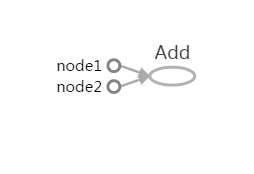
图 32
注意:
文档中的 Python 示例使用一个会话 Session 来 启动图, 并调用 Session.run() 方法执行操作.为了便于使用诸如 IPython 之类的 Python 交互环境, 可以使用 InteractiveSession 代替 Session 类, 使用 Tensor.eval() 和 Operation.run() 方法代替 Session.run(). 这样可以避免使用一个变量来持有会话.
|
# 进入一个交互式 TensorFlow 会话. import tensorflow as tf sess = tf.InteractiveSession()
x = tf.Variable([1.0, 2.0]) a = tf.constant([3.0, 3.0])
# 使用初始化器 initializer op 的 run() 方法初始化 ‘x‘ x.initializer.run()
# 增加一个减法 sub op, 从 ‘x‘ 减去 ‘a‘. 运行减法 op, 输出结果 sub = tf.sub(x, a) print sub.eval() # ==> [-2. -1.] |
目前了解的,TensorFlow有三种类型的起始节点:constant(常量)、placeholder(占位符)、Variable(变量)。
TensorFlow的常量节点是通过constant方法创建,其是Computational Graph中的起始节点,在图中以一个圆点表示,如图 32所示。
如下述程序中所示,直接创建,但创建的节点不会开始执行,需要由Session对象的run方法开始启动。
|
tensor1 = tf.constant(3., tf.float32) print(tensor1)
tensor2 = tf.constant([1, 2, 3, 4, 5, 6, 7]) print(tensor2)
tensor3 = tf.constant(-1.0, shape=[2, 3]) print(tensor3)
session = tf.Session() print(session.run(tensor1)) print(session.run(tensor2)) print(session.run(tensor3)) |
|
输出: Tensor("Const:0", shape=(), dtype=float32) Tensor("Const_1:0", shape=(7,), dtype=int32) Tensor("Const_2:0", shape=(2, 3), dtype=float32) 3.0 [1 2 3 4 5 6 7] [[-1. -1. -1.] [-1. -1. -1.]] |
TensorFlow的placeholder节点是由placeholder方法创建,其也是一种常量,但是由用户在调用run方法是传递的,也可以将placeholder理解为一种形参。即其不像constant那样直接可以使用,需要用户传递常数值。
如下所示在执行node3:
|
import tensorflow as tf
node1 = tf.placeholder(tf.float32) node2 = tf.placeholder(tf.float32) tensor = tf.add(node1, node2)
print(node1) print(node2)
session = tf.Session() print(session.run(tensor, {node1:3,node2:4} )) |
|
输出: Tensor("Placeholder:0", dtype=float32) Tensor("Placeholder_1:0", dtype=float32) 7.0 |
注意:
由于在执行node3节点时,需要node1和node2作为输入节点,所以此时需要传递"实参",即3和4.
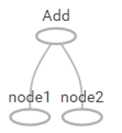
图 41
TensorFlow的Variable节点是通过Variable方法创建,并且需要传递初始值。常量在执行过程中无法修改值,变量可以在执行过程修改其值。但是TensorFlow的变量在创建之后需要再进行手动初始化操作,而TensorFlow常量在创建时就已进行了初始化,无需再进行手动初始化。
如下示例,创建两个变量,分别初始化为0.3和-0.3,然后传入一个向量值,最后计算出一个新的向量:
|
from __future__ import print_function import tensorflow as tf
w = tf.Variable([.3], tf.float32) b = tf.Variable([-.3], tf.float32) x = tf.placeholder(tf.float32)
linear = w * x + b
session = tf.Session() init = tf.global_variables_initializer() session.run(init)
print(session.run(linear, {x: [1, 2, 3, 4]})) |
|
输出: [ 0. 0.30000001 0.60000002 0.90000004] |
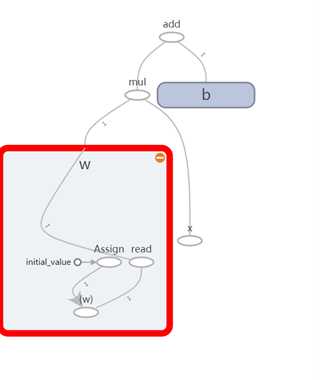
图 42
从W展开细节看,变量其实只是一个命名空间,其内部由一系列的节点和边组成。同时有一个常量节点,即初始值节点。
模型评估是指比较期望值和模型产生值之间的差异,若差异越大,则性能越差;差异越小,性能越好。模型评估有很多种方法,如均分误差或交差熵。
如下以常用的"均分误差"法举例说明,其等式为:
![]()
Y为期望向量,X为输入向量,f(X)为计算向量,如下所示:
|
from __future__ import print_function import tensorflow as tf #1. 构建计算流图 w = tf.Variable([.3], tf.float32) b = tf.Variable([-.3], tf.float32) x = tf.placeholder(tf.float32) y = tf.placeholder(tf.float32) #期望向量 linear_model = w * x + b
squared_deltas = tf.square(linear_model - y) #对两个向量的每个元素取差并平方,最后得出一个新的向量 loss = tf.reduce_sum(squared_deltas) #对向量取总和
#2. 执行计算流图 session = tf.Session() init = tf.global_variables_initializer() session.run(init)
print(session.run(loss, {x: [1, 2, 3, 4], y: [0, -1, -2, -3]})) |
|
输出: 23.66 |
注意:
loss的值是依赖W、B和Y三个向量的值,所以计算loss Tensor会根据依赖关系获取W、B和Y三个Tensor的值,其计算流程图如图 51所示:
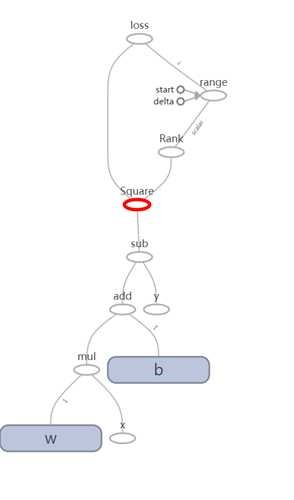
图 51
优化是指减少期望值与模型产生值之间的差异,即减少均分误差或交差熵的计算结果,如减少上述的loss变量值。
我们可以通过修改上述的w和b的变量值,来手动优化上述的模型。由于TensorFlow的变量是通过tf.Variable方法创建,而重新赋值是通过tf.assign方法来实现。注意修改变量的动作需要执行Session.run方法来开始执行。
比如可以修改w=-1,b=1参数来优化模型,如下
|
from __future__ import print_function import tensorflow as tf
w = tf.Variable([.3], tf.float32) b = tf.Variable([-.3], tf.float32) x = tf.placeholder(tf.float32) y = tf.placeholder(tf.float32 ") linear_model = w * x + b
squared_deltas = tf.square(linear_model - y) loss = tf.reduce_sum(squared_deltas)
session = tf.Session() init = tf.global_variables_initializer() session.run(init)
#1.变量w和b初始值为3和-3时,计算loss值 print(session.run(loss, {x: [1, 2, 3, 4], y: [0, -1, -2, -3]}))
#2.重置变量w和b值为-1和1时,再计算loss值 fixw = tf.assign(w,[-1.]) fixb = tf.assign(b,[1.]) session.run(fixw) session.run(fixb) print(session.run(loss, {x:[1,2,3,4],y:[0,-1,-2,-3]})) |
|
输出: 23.66 0.0 |
注意:
loss的值是依赖W、B和Y三个向量的值来计算,即每次计算loss都需要上述三个变量的值进行计算。由于通过调用Session.run()方法来执行某个节点(Computational graph的节点为操作)时,会自动根据节点前后依赖关系,自动从初始节点开始计算到该节点。在第一次执行session.run(loss)时,W和B的值是3和-3;第二次执行session.run(loss)时,W和B的值被修改为-1和1后。所以session.run(loss)时会自动根据W和B的不同进行计算。
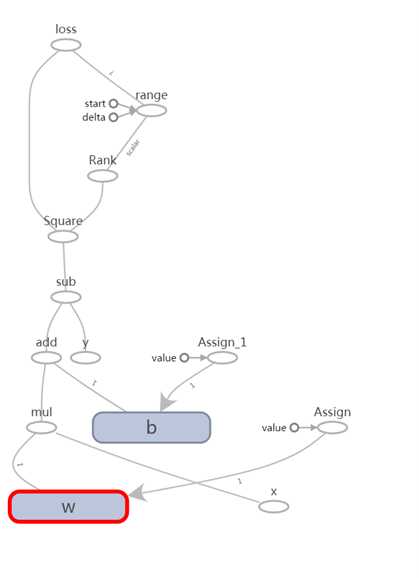
图 61
上述通过手动调整变量w和b的值来改善模型的执行性能,虽然也行的通,但是非常单调且工作量太大。所以TensorFlow提供一些优化器(optimizers)来提高用户的工作效率,可以自动完成优化,即可以自动更新相关变量的值。
如下所示,以最简单的优化器gradient descent为例,其可以根据执行loss值逐渐修改每个变量值,:
|
import numpy as np import tensorflow as tf w = tf.Variable([.3], tf.float32) b = tf.Variable([-.3], tf.float32) x = tf.placeholder(tf.float32) linear_model = w * x + b y = tf.placeholder(tf.float32)
squared_deltas = tf.square(linear_model - y) loss = tf.reduce_sum(squared_deltas)
#1. optimizer optimizer = tf.train.GradientDescentOptimizer(0.01) train = optimizer.minimize(loss)
#2. training loop init = tf.global_variables_initializer() session = tf.Session() session.run(init)
for i in range(1000): session.run(train, {x:[1,2,3,4], y:[0, -1, -2, -3]})
#3. evaluate training accuracy curr_w, curr_b, curr_loss = session.run([w,b,loss], {x:[1, 2, 3, 4], y:[0, -1, -2, -3]}) print("w:%s b:%s loss:%s"%(curr_w,curr_b,curr_loss)) |
|
输出: w:[-0.9999969] b:[ 0.99999082] loss:5.69997e-11 |
注意:

则dV是参数调整数幅度,如若v是权值w,则
如图 62所示是产生的Computational graph图变换:
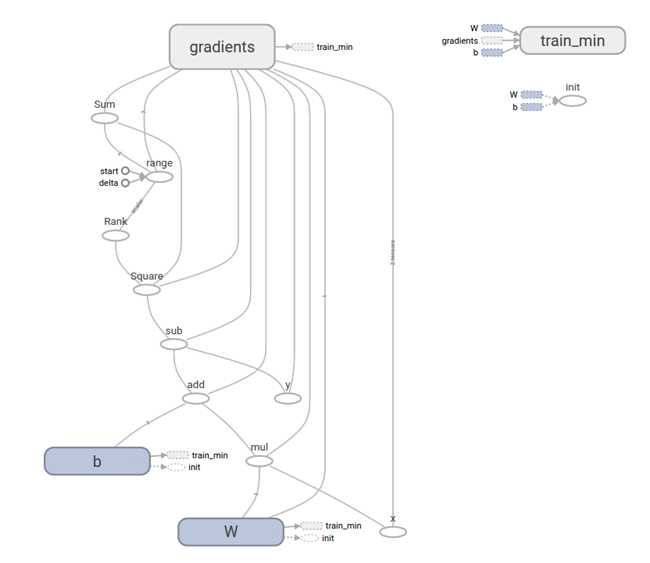
图 62
图中带有箭头的边缘是指依赖,如节点b有一个指向tain_min节点,表明b的值依赖tain_min节点。
TensorFlow框架之Computational Graph详解
标签:ica 直接 命名空间 display 简单 之间 描述 常用 计算
原文地址:http://www.cnblogs.com/hlwfirst/p/7439653.html